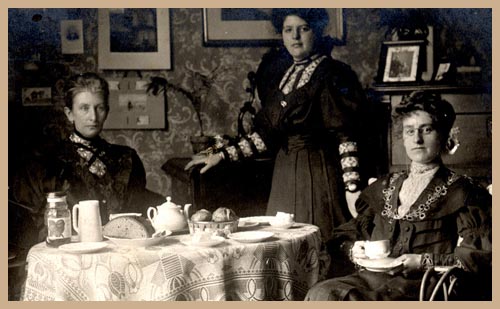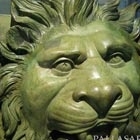Find out about what bronze patinas are, how they are applied, popular colors and finishes for railings, gates sculptures and metal art objects.
Care of the Pantry
The care of the pantry includes:
- Care of the food left from a meal.
- " "fruit, relishes, bread, cake, cheese, crackers, etc.
- Care of refuse food.
- " " refrigerator.
- " " china, glass, etc.
- " " silver.
- " " teakettle, tea and coffee pots.
- " " sink, dish pans, towels, cloths, etc. .
- " " cupboards, shelves, jars, boxes, etc.
- " " gas stove or heating appliances.
Things needed in the care of the pantry:
- I dish pan. I rinsing pan.
- I grooved hard-wood dish drainer. I sieve to hold spent tea leaves and coffee grounds. 3 or 4 wide-mouthed pitchers for soaking silver utensils.
- 1 soap shaker.
- 1 dish mop.
- 2 dishcloths (new linen, replenished often).
- 1 soft brush for glass.
- " " " silver.
- 6 or more fine towels for glass, silver, and fine china.
- 6 or more soft but coarser towels for ordinary
china. - 6 crash towels for occasional use. l large piece chamois skin. i " box of basswood or boxwood sawdust. Fine Quality of common soap or Ivory Soap, Sapolio and Bristol brick, i bottle of household ammonia.
- 1 box of powdered borax.
- 2 pounds (or more) of sal-soda.
- 1 box of electro-silicon.
- 1 pound of whiting.
- Flannel for scouring.
- Old linen napkins for polishing, etc.
- 1 bottle of sweet oil (for wood finish)
- 1 " " turpentine (for wood finish)
- Safety match holder.
- A refuse can with cover.
- Hamper for soiled linen.
THE PANTRY AT MEAL TIME
When a meal is announced have the pantry in perfect order, with each article in its appropriate and accustomed place. The plates for roasts and other hot dishes should have been standing in the warming oven or hot closet from twenty minutes to half an hour. Put the dishes for salads and ices in the refrigerator just before announcing the meal.
Reserve convenient and commodious places for the bestowal of dishes of food, of silver and china, brought from the dining-room. Retain these places at every meal for the purpose selected, as this will conduce to celerity in serving and care of the table appointments.
 CARE OF FOOD LEFT FROM A MEAL
CARE OF FOOD LEFT FROM A MEAL
Do not send choice platters containing food to the kitchen. Remove food that is not to reappear on the table in the same form to plates kept for that purpose and send these to the kitchen at once. Do not leave any food standing around in the pantry. Do not throw slices of bread back into the stone jar in which the loaves are stored; keep them in a separate receptacle. Wrap little cakes or parts of loaves of cake in waxed paper and store in a tin box. Return confectionery and salted almonds to original boxes, wrap these in paper, and store in a drawer or closed receptacle. Wrap cheese closely in paper, then in tin-foil and then store in a cool, dry place. Return olives to original brine; add salt and water, if needful to cover, and set aside in the refrigerator. Return milk and cream to jars, put in the same or fresh stoppers, and set the jars in the refrigerator. Store no food in the pantry refrigerator except such as will be sent to the table without further cooking.
MAKING READY FOR DISH WASHING
- Scrape all bones and refuse from the plates into a large earthen receptacle kept for the purpose and remove this to the garbage pail at once. Wipe out the dish with a soft paper or old cloth, which may be burned, then wash the dish with soapy water and rinse with hot water.
- With a bit of bread wipe off the plates, platters, and bowls, or, water being plenty, rinse these with cold water and wipe out the bowls of spoons with the bread, Dispose the coarser ware in piles, but under no consideration should pieces of choice china and glass be piled one above another.
- Put silver knives, forks, tablespoons, teaspoons, and steel knives in separate pitchers of lukewarm, soapy water; do not let the handles of the steel knives touch the water. Fill cream and milk pitchers with cold water and set aside until ready to wash. Turn the contents of the tea and coffee pots into a fine drainer in the sink, and fill the pots with hot water.
- Take up any crumbs that may have been dropped on shelves or floor; wipe off the shelves, where the dishes have stood, and the floor, if anything has been dropped upon it.
WASHING DISHES
Have one pan filled with moderately hot, soapy water and another with clear hot water. Change these waters often. Wash the dishes in the first water and rinse in the second, wipe glass at once, set china to drain on a grooved, hard-wood drainer that is inclined toward the sink. Never wash dishes with a cake of soap lying in the water.
WASHING GLASS
Wash the glass, one piece at a time, using a soft brush as needed. Great care must be taken with the pans, towels, cloth, and water used in washing and wiping glass. If glass be scratched in any way, even slightly, it is weakened, and is almost sure to break at that point. One grain of sand, such as is often seen in the bottom of a pan in which lettuce or spinach has been washed, has been the occasion for the loss of many a piece of fine glass.
Glass that is deeply cut is not easily dried; the moisture remains in the crevices. Bury the glass as soon as dried in a box of fine boxwood or basswood sawdust (sawdust from woods of a resinous nature, as pine and spruce, is not suitable for this purpose). Let the glass stand half an hour or longer, then remove from the box, and brush with a soft cloth or chamois. Spread the sawdust out to dry, then set aside to use again.
WASHING AND CLEANING SILVER
Wash the silver after the glass, reheating the water or taking a fresh supply. Have plenty of soap in the water. Use the soap shaker to make the suds, and on no account let a cake of soap remain in the water. When the silver is washed and rinsed, take out on to the drainer (a grooved hard-wood plank sloping toward the sink) and wipe dry as soon as possible. If any of the silver has been tarnished with eggs or similar substance, wet a little sifted whiting with ammonia or alcohol, diluted with a little water, and apply this with a soft cloth, and let the silver stand on a paper to dry, then rub off the whiting with a soft cloth and polish with a second cloth or chamois. About once a month clean all the silver in the same way, using a soft brush for chased and ornamented pieces.
WASHING CHINA
Several cups, saucers, or small dishes may be put into the pan at once. Make sure that each is empty, lest the dishwater be spoiled. Rinse each one as washed, and set it to drain; then, when all are washed, the first piece will be ready to wipe. Wash the larger dishes one at a time. Change the water often. Too hot or too soapy water will injure color and gilding and cause the finish to crackle. Avoid having more than one kind of china in the pan at a time. Breakage results from a commingling of dishes of different sizes and shapes.Service plates of rare and costly china sould have rounds of canton flannel laid between them, to save from possible scratches, when put away on the pantry shelves.Delicate china cups should never be stored one inside the other, but each hung on a hook by the handle.
WASHING STEEL KNIVES AND CARVERS
After washing the blades of steel knives, scour them with Bristol brick or sand soap; apply this with a woollen cloth or a cork moistened with soap or water. Wash and rinse the blades in moderately hot water; wipe the handles with a soft damp cloth, and rub the blades with a soft dry cloth until they are perfectly dry. Use only lukewarm water in caring for carvers.
CARE OF TEA AND COFFEE POTS
Unless special care be needed, it is probably best to clean and dry tea and coffee pots when making ready to wash dishes. Never, on any account, put soapy water into these receptacles. Turn the contents into the drainer in the sink, which should be fine enough to keep back coffee grounds, wash with clear water and a cloth used for no other purpose; use a wooden skewer covered with a cloth to clean crevices, rinse with boiling water, wipe dry^ and set aside. Remove discolorations from the inside with the article generally used to cleanse the material of which the pots are made, as whiting wet with ammonia or dilute alcohol for silver, china, or stone ware. Fill agate-lined pots with boiling water to which a generous teaspoonful of sal-soda has been added; let stand on the back of the gas range half an hour, then wash with clear water as above.
CARE OF TEAKETTLE
After each meal empty the teakettle and dry it. Once a day wash thoroughly, scald with boiling water, and wipe dry. This insures a clean kettle and fresh-drawn water for the making of tea and coffee, which is the principle use of a teakettle in the pantry.
CARE OF CRUMB TRAY, BREAD TRAY, SALTS, ETC.
Wash and wipe the carafes, all trays that have been used in the dining-room, as also the outside .of the oil and vinegar cruets and the salt and pepper shakers. Once a week these will need more particular attention. For external cleaning see care of silver and cut glass.
CLEANING CARAFES, OIL AND VINEGAR CRUETS
Cleaning Carafes
Put two level tablespoonfuls of rice, two or three pieces of sal-soda as large as a hickory nut, and a cup of warm water into the carafe, cover the top with several thicknesses of old linen or with a towel folded several times, bring the ends down around the stem, and surround the whole with the hand; then using both hands shake the bottle vigorously, to insure the friction of the rice upon every part of the glass. When the bottle is thoroughly cleansed, pour out the water, retaining the rice, put in a cup of warm water, cover and shake as before, then turn out both rice and water and rinse thoroughly with clean water, changing it once or twice. Wipe dry with a soft cloth.
Cleaning the Vinegar Cruet
Clean in the same manner as the water bottle, using warm soapsuds without sal-soda and half the quantity of rice.
Cleaning the Oil Cruet
Use the sal-soda and water first, to remove a part of the oil, then add the rice, and finish as above.
CARE OF DISH TOWELS, ETC.
Wash in hot, soapy water all salad cloths, dish towels, dish mops, and dishcloths that have been used; wash these in the order mentioned, scald in hot water, rinse in cold water, shake and snap out, then hang in the open air to dry. Once a week, after all are washed, add a little borax to the water and let the linen scald half an hour, then rinse in two waters. When dry, dampen, and after some little time iron smoothly, and when well aired put each variety in its proper place.
CARE OF SINK, ETC.
Wash out the sink, to leave it absolutely free of grease ; scour the faucets, dipper, hand basin, or whatever utensils are kept at the sink. Leave each and every one clean and dry. Once a week pour a strong solution of sal-soda (one cup to five quarts of water) down the sink pipe and follow it at once with a profuse flushing with hot water. With this care, if dishes be properly prepared for washing and dishcloths be discarded before they become linty, the sink should always be in good condition. If the drain pipe should become clogged, a plumber should be sent for. A strong solution of sal-soda, even of lye, may be used as long as the pipe is open and the waste running, but, when the pipe is really clogged, the lye is apt to settle around the joints, injure the plumbing, and prove an obstacle when the plumber is called upon to remove and clean the trap.
CARE OF REFRIGERATOR
A refrigerator for the special use of the waitress will be found in few houses, but if the family be large or one that entertains much, the quality of the service will more than compensate for the first outlay. The waste pipe should not be connected with the drain pipe of the house, A pan that needs to be emptied each day, set beneath to catch the waste, is far preferable to the dangers that lurk in a common drain pipe. The main points in the care of the average refrigerator might be summarized as below. Some of the new refrigerators are so made that they can be kept in perfect order at all times without regard to the ice supply.
- When anything is spilled on the shelves, wipe it up thoroughly and immediately.
- Once a week, when the supply of ice is low, wash the racks, shelves, and every part of the inside in hot soda-water, rinse in boiling water, and dry the movable parts in the open air. Wash out the waste pipe with soapsuds, then with hot soda-water, and finally rinse with boiling water. For the waste pipe use a cloth on a wire or rod, that the work may be thoroughly done.
- When every part is thoroughly aired and dried, renew the ice, and, when the refrigerator is thoroughly chilled, it is ready for use.
CARE OF GAS RANGE
As but little or no cooking is done upon the gas range it will be a very simple matter to keep it clean. In keeping articles hot in a double boiler or similar receptacle, have the flame turned low, to avoid both the boiling over and the quick evaporation of the water. Wipe all parts of the range daily with a soft cloth and keep it dry. Occasionally it may need blacking and polishing.
When alcohol lamps are used to keep water, milk, etc., at the proper temperature, or for making tea and coffee, change the wicks occasionally. If Sternau lamps be used, fill the lamp through the central opening, and on no account light the lamp until this opening has been covered with its proper cap.




